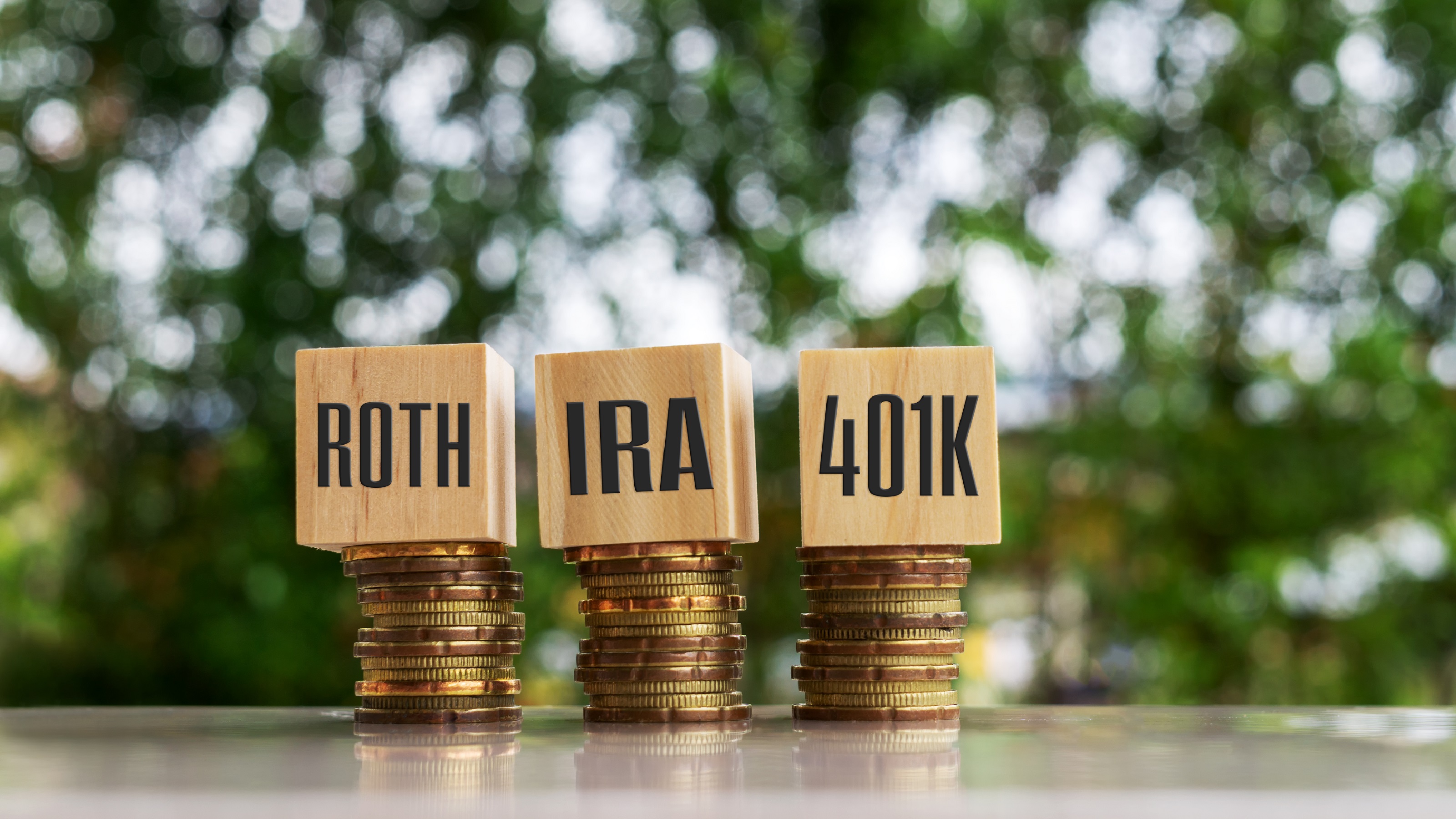IRA vs Roth vs 401(k): Which Do You Pick?
All offer great tax breaks as you save for retirement. In addition, there are 403(b), SEP and SIMPLE plans and more. But don't worry. It’s hard to go wrong.


For the past 20 years, a majority of Americans have saved and invested for retirement on their own because company pension plans are largely a thing of the past. Living on Social Security alone during retirement isn’t appealing for most of us, since the maximum benefit is around $46,000/year for 2024. But how much and where should we invest for retirement?
The short answer: Most people should be saving and investing about 15% of their annual income into a retirement savings/investment plan, such as an IRA or 401(k) or 403(b), or some combination.
Saving for retirement through your employer
Companies typically offer some form of retirement savings plan, with employee contributions coming directly out of their paychecks. Often, these are 401(k) or 403(b) plans but could also be 457 or deferred compensation plans, depending on the employer and type of business. Many, but not all, companies will match a specific percentage of their employees’ contributions. If you’re lucky enough to have this option, you should take advantage of it, because it’s free money.
From just $107.88 $24.99 for Kiplinger Personal Finance
Become a smarter, better informed investor. Subscribe from just $107.88 $24.99, plus get up to 4 Special Issues

Sign up for Kiplinger’s Free Newsletters
Profit and prosper with the best of expert advice on investing, taxes, retirement, personal finance and more - straight to your e-mail.
Profit and prosper with the best of expert advice - straight to your e-mail.
Investment options for these types of retirement savings plans are generally selected by the employees from a pre-defined list of 15 to 50 mutual funds or similar options. The IRS does set annual contribution limits for the employee portion, which for 2024, was $23,000 for employees under age 50 and $30,500 for employees 50 or older.
Saving on your own
If you work for a small company or for yourself, as an independent contractor, you may not have a company-sponsored 401(k), 403(b) or 457 plan available. In this case, you could set up a Simplified Employee Pension, or SEP IRA, plan if you own your own business or work for yourself as a consultant or entrepreneur. Small companies sometimes do offer a SIMPLE IRA plan, which operates much like a 401(k) but has lower annual contribution limits and requires employers to match at a specific safe-harbor level.
If none of those is available, employees can contribute to their own individual retirement account, or IRA, set up directly with a brokerage firm or bank. IRAs come in two “flavors”: traditional IRAs and Roth IRAs. Their annual IRA contribution limits are even lower than the others mentioned — just $7,000 for those under 50 and $8,000 for those 50 and older. In addition, sometimes higher-income individuals may be prohibited from making contributions altogether (e.g., Roth IRA) or may lose the tax deduction (e.g., traditional IRA). On the plus side, investment options in IRAs are virtually unlimited, with most any stock, bond, ETF or mutual fund available.
Some major tax breaks
One key aspect of these retirement savings plans is their favorable tax treatment. For simplicity, there are two distinct tax advantages associated with these types of plans: (1) tax deduction of employee’s contribution or (2) tax-free withdrawals during retirement. However, each plan gets one or the other — but not both — tax advantages.
For example, most legacy 401(k) plans and traditional IRAs, along with SIMPLE and SEP IRAs, provide a tax deduction for employee contributions. But later, in retirement, all monies distributed from these plans are considered taxable income. The tax benefit comes on the front end, when contributions are made. Once a retiree turns 73 years old, required minimum distributions (RMDs) apply, necessitating withdrawals be taken according to an IRS table. These withdrawals are taxed as ordinary income.
In contrast, Roth IRAs do not provide a front-end tax benefit, meaning employee contributions to Roth IRAs are not deductible. But unlike traditional IRAs, Roth IRA distributions come out tax-free during retirement if the Roth account has been in place for five or more years, and the employee is 59½ years old or older. Roth IRA tax benefits are accrued on the back end, meaning they kick in during retirement, when distributions are taken to supplement Social Security income.
Today, many employer-sponsored retirement plans also allow employee 401(k) contributions to be designated as Roth. This is an excellent way to build up a large retirement account, which may be available tax-free in retirement. And because monies inside a Roth account have already been taxed, no RMDs are generally required.
Which is better: Traditional or Roth?
Both, actually! Using either or both retirement savings/investing vehicle is better than not saving/investing at all. And when it comes to saving for retirement, sooner is always better than later, and higher contributions are always better than lower.
If I were advising a 25-year-old employee just starting out and making $50,000 per year, I’d suggest building up their Roth 401(k) and/or Roth IRA as much as possible, because a tax deduction at that income level isn’t as critical at this juncture. But, if my client were 58 years old and making $650,000 annually, I’d suggest they use all the tax deductions they can get right now because they’re in a very high tax bracket already. This means using a traditional 401(k) or IRA for this client would be my suggestion.
Related Content
- The Average 401(k) Balance by Age
- Five Ways to Catch Up on Retirement Savings
- Here’s a Step-by-Step Guide to Retirement Planning by Age
- The 'Magic Number' Needed to Retire Comfortably Is More Than You Think
- How to Open a Roth IRA in Five Simple Steps
Profit and prosper with the best of Kiplinger's advice on investing, taxes, retirement, personal finance and much more. Delivered daily. Enter your email in the box and click Sign Me Up.

Scott joined Ballast Rock Private Wealth (BRPW) as a Senior Wealth Advisor and CFP® (Certified Financial Planner) in October 2023. At BRPW, Scott specializes in financial planning, wealth management and investment strategies for accredited individuals, families, professionals, business owners and company executives. He became a CFP® in 2011, enabling him to offer a broader array of services spanning investments, insurance, retirement planning, estate planning and tax mitigation strategies. 2019 through 2024, Scott has won the Five Star Wealth Manager award from Five Star Professional.
-
 December Fed Meeting: Live Updates and Commentary
December Fed Meeting: Live Updates and CommentaryThe December Fed meeting is one of the last key economic events of 2025, with Wall Street closely watching what Chair Powell & Co. will do about interest rates.
-
 This Is Why Investors Shouldn't Romanticize Bitcoin
This Is Why Investors Shouldn't Romanticize BitcoinInvestors should treat bitcoin as the high-risk asset it is. A look at the data indicates a small portfolio allocation for most investors would be the safest.
-
 I'm a Federal Benefits Pro: I Answer These 2 Questions a Lot
I'm a Federal Benefits Pro: I Answer These 2 Questions a LotMany federal employees ask about rolling a TSP into an IRA and parsing options for survivor benefits, both especially critical topics.
-
 Why Investors Shouldn't Romanticize Bitcoin, From a Financial Planner
Why Investors Shouldn't Romanticize Bitcoin, From a Financial PlannerInvestors should treat bitcoin as the high-risk asset it is. A look at the data indicates a small portfolio allocation for most investors would be the safest.
-
 I'm a Financial Pro Focused on Federal Benefits: These Are the 2 Questions I Answer a Lot
I'm a Financial Pro Focused on Federal Benefits: These Are the 2 Questions I Answer a LotMany federal employees ask about rolling a TSP into an IRA and parsing options for survivor benefits, both especially critical topics.
-
 Private Credit Can Be a Resilient Income Strategy for a Volatile Market: A Guide for Financial Advisers
Private Credit Can Be a Resilient Income Strategy for a Volatile Market: A Guide for Financial AdvisersAdvisers are increasingly turning to private credit such as asset-based and real estate lending for elevated yields and protection backed by tangible assets.
-
 5 RMD Mistakes That Could Cost You Big-Time: Even Seasoned Retirees Slip Up
5 RMD Mistakes That Could Cost You Big-Time: Even Seasoned Retirees Slip UpThe five biggest RMD mistakes retirees make show that tax-smart retirement planning should start well before you hit the age your first RMD is due.
-
 I'm a Wealth Adviser: My 4 Guiding Principles Could Help You Plan for Retirement Whether You Have $10,000 or $10 Million
I'm a Wealth Adviser: My 4 Guiding Principles Could Help You Plan for Retirement Whether You Have $10,000 or $10 MillionRegardless of your net worth, you deserve a detailed retirement plan backed by a solid understanding of your finances.
-
 A Retirement Triple Play: These 3 Tax Breaks Could Lower Your 2026 Bill
A Retirement Triple Play: These 3 Tax Breaks Could Lower Your 2026 BillGood news for older taxpayers: Standard deductions are higher, there's a temporary 'bonus deduction' for older folks, and income thresholds have been raised.
-
 If You're Retired or Soon-to-Be Retired, You Won't Want to Miss Out on These 3 OBBB Tax Breaks
If You're Retired or Soon-to-Be Retired, You Won't Want to Miss Out on These 3 OBBB Tax BreaksThe OBBB offers some tax advantages that are particularly beneficial for retirees and near-retirees. But they're available for only a limited time.
-
 Waiting for Retirement to Give to Charity? Here Are 3 Reasons to Do It Now, From a Financial Planner
Waiting for Retirement to Give to Charity? Here Are 3 Reasons to Do It Now, From a Financial PlannerYou could wait until retirement, but making charitable giving part of your financial plan now could be far more beneficial for you and the causes you support.